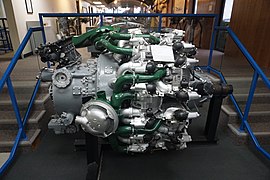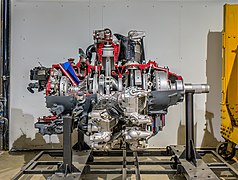Wright R-3350 Duplex-Cyclone
This article needs additional citations for verification. (January 2009) |
| R-3350 Duplex-Cyclone | |
|---|---|
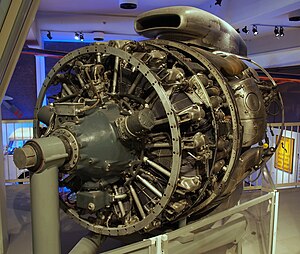
| |
| Type | Radial engine |
| National origin | United States |
| Manufacturer | Wright Aeronautical |
| First run | May 1937 |
| Major applications | Boeing B-29 Superfortress Fairchild C-119 Flying Boxcar Douglas A-1 Skyraider Douglas DC-7 Lockheed Constellation Lockheed P-2 Neptune Douglas XB-19 |
| Number built | 29,181[1] |
| Developed from | Wright R-1820 Cyclone |
| Developed into | Wright R-4090 Cyclone 22 |
The Wright R-3350 Duplex-Cyclone is an American twin-row, supercharged, air-cooled, radial aircraft engine with 18 cylinders displacing nearly 3,350 cubic inches (54.9 L). Power ranged from 2,200 to 3,700 hp (1,640 to 2,760 kW), depending on model. Developed before World War II, the R-3350's design required a long time to mature, and was still experiencing problems with reliability when used to power the Boeing B-29 Superfortress.
After the war, the engine had matured sufficiently to be used in many civilian airliners, notably in its turbo-compound forms, and was used in the Lockheed L-1049 Super Constellation airliners into the 1950s. Its main rival was the 4,360 in3 (71.4 L), 4,300 hp (3,200 kW) Pratt & Whitney R-4360 Wasp Major, which first ran some seven years after the Duplex-Cyclone. The engine is commonly used on Hawker Sea Fury and Grumman F8F Bearcat Unlimited Class Racers at the Reno Air Races.
Design and development
[edit]In 1927, Wright Aeronautical introduced its "Cyclone" engine, which powered a number of designs in the 1930s. After merging with Curtiss to become Curtiss-Wright in 1929, an effort was started to design an engine in the 1,000 hp (750 kW) class. The new Wright R-1820 Cyclone 9 first ran in 1935, and became one of the most used aircraft engines in the late 1930s and early 1940's, powering the Boeing B-17 Flying Fortress heavy bomber, General Motors FM-2 Wildcat fighter and Douglas SBD Dauntless dive bomber, among many others.
By 1931 Pratt & Whitney had started a development of their single-row Wasp nine-cylinder engine into the larger and much more powerful fourteen-cylinder, twin-row R-1830 Twin Wasp with a similar 1,800 in3 (30 L) displacement that would easily compete with the single-row Cyclone. In 1935 Wright followed P&W's lead, and developed larger engines based on the Cyclone. The result was two designs, a 14-cylinder short stroke design of nearly 2,600 in3 (43 L) displacement that would evolve into the Wright R-2600 Twin Cyclone, and a much larger 18-cylinder design that became the R-3350. A larger twin-row 22-cylinder version, the Wright R-4090 Cyclone 22, was experimented with as a competitor to the 4,360 in3 (71.4 L) displacement four-row, 28-cylinder Pratt & Whitney R-4360 Wasp Major, but was not produced.
With Pratt & Whitney starting development of their own 2,800 in3 (46 L) displacement 18-cylinder, twin-row radial as the R-2800 Double Wasp in 1937, Wright's first R-3350 prototype engines with a 3,350 in3 (54.9 L) displacement were run in May of the same year. Development was slow, due to the complexity, and the R-2600 receiving development priority. The R-3350 did not fly until 1941, after the Douglas XB-19 had been redesigned to use R-3350s instead of Allison V-3420 inlines.
Things changed dramatically in 1940 with the introduction of a new contract by the USAAC to develop a long-range bomber capable of flying from the US to Germany with 20,000 lb (9,100 kg) of bombs. Although smaller than the Bomber D designs that led to the Douglas XB-19, the new designs required just as much power. When four preliminary designs were presented in mid-1940, three of them used the R-3350. Suddenly development was a priority, and serious efforts to get it into production began. In 1942 Chrysler started building the Dodge Chicago Plant, which was ready by early 1944.
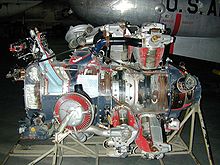
By 1943 the new Boeing B-29 Superfortress was flying with R-3350s. The engines remained temperamental, and the rear cylinders tended to overheat, partially due to inadequate clearance between the cylinder baffles and the cowl. A number of changes were introduced to improve cooling, and the aircraft was rushed into service in the Pacific in 1944. This proved unwise, as the early B-29s taking off at maximum weights, in the high temperature conditions of the B-29s tropical airfields, caused overheating that was not completely solved, and the engines also had a tendency to swallow valves. Because of a high magnesium content in the crankcase, engine fires could burn with a core temperature approaching 5,600 °F (3,090 °C)[2] which could burn through the main spar in seconds, causing a catastrophic failure.[3]
Early R-3350s used carburetors, though the poorly designed elbow entrance to the supercharger led to serious problems with fuel/air mixtures. Near the end of WWII, the system was changed to use gasoline direct injection which improved reliability. After the war the engine was redesigned and became popular for large aircraft, notably the Lockheed Constellation and Douglas DC-7.
Following the war, the Turbo-Compound[4] system was developed to deliver better fuel efficiency. In these versions, three power-recovery turbines (PRT) were inserted into the exhaust of each group of six cylinders, and geared to the crankshaft by fluid couplings to deliver more power. The PRTs recovered about 20% of the exhaust energy (around 450 hp (340 kW)) that would have otherwise been lost, but reduced engine reliability. Mechanics nicknamed them Parts Recovery Turbines, since the increased exhaust heat meant a return to the engine destroying exhaust valves. The fuel burn for the PRT-equipped aircraft was nearly the same as the older Pratt and Whitney R-2800, while producing more useful power.[5] Effective 15 October 1957 a DA-3/DA-4 engine cost $88,200.[6]
By this point reliability had improved with the mean time between overhauls at 3,500 hours and specific fuel consumption in the order of 0.4 lb/hp/hour (243 g/kWh, giving a 34% fuel efficiency). Engines in use as of the 2020s are limited to 52 inHg (180 kPa) manifold pressure, giving 2,880 hp (2,150 kW) with 100/130 octane fuel (or 100LL) instead of the 59.5 inHg (201 kPa) and 3,400 hp (2,500 kW) possible with 115/145, a higher octane fuel, which is no longer available.
Several racers at the Reno Air Races use R-3350s. Modifications on one, Rare Bear, include a nose case designed for a slow-turning prop, taken from an R-3350 used on the Lockheed L-1649 Starliner, mated to the power section (crankcase, crank, pistons, and cylinders) taken from an R-3350 used on the Douglas DC-7. The supercharger is taken from an R-3350 used on the Lockheed EC-121 and the engine is fitted with nitrous oxide injection. Normal rated power of the original stock R-3350 was 2,800 hp (2,100 kW) at 2,600 rpm and 45 inHg (150 kPa) of manifold pressure. With these modifications, Rare Bear's engine produces 4,000 hp (3,000 kW) at 3,200 rpm and 80 inHg (270 kPa) of manifold pressure, and 4,500 hp (3,400 kW) with nitrous oxide injection.[7]
Variants
[edit]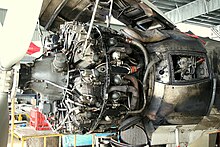
- R-3350-13
- 2,200 shp (1,640 kW)
- R-3350-23
- 2,200 shp (1,640 kW)
- R-3350-24W
- 2,500 shp (1,860 kW)
- R-3350-26W
- 2,800 shp (2,090 kW)
- R-3350-30W
- R-3350-30WA
- R-3350-32W
- 3,700 shp (2,760 kW)
- R-3350-34
- 3,400 shp (2,540 kW)
- R-3350-35A
- 2,200 shp (1,640 kW)
- R-3350-41
- Fuel injected Silverplate variant[8]
- R-3350-42WA
- 3,800 shp (2,830 kW)
- R-3350-53
- 2,700 shp (2,010 kW)
- R-3350-57
- 2,200 shp (1,640 kW)
- R-3350-85
- 2,500 shp (1,860 kW)
- R-3350-89A
- 3,500 shp (2,610 kW)
- R-3350-93W
- 3,500 shp (2,610 kW)
- 972TC18DA1
- Commercial equivalent to the -30W without water injection
- 956C18CA1
- Commercial, similar to the -26W
- 975C18CB1
- Commercial, similar to the 956C18CA1
Applications
[edit]- Beechcraft XA-38 Grizzly
- Boeing B-29 Superfortress
- Boeing XC-97 Stratofreighter
- Boeing XPBB Sea Ranger
- Canadair CP-107 Argus
- Consolidated B-32 Dominator
- Curtiss XBTC-2
- Curtiss XF14C
- Curtiss XP-62
- Douglas A-1 Skyraider
- Douglas BTD Destroyer
- Douglas DC-7
- Douglas XB-19
- Douglas XB-31
- Fairchild C-119 Flying Boxcar
- Fairchild AC-119
- Grumman F8F Bearcat (See the Rare Bear)
- Hawker Sea Fury
- Lockheed Constellation
- Lockheed L-049 Constellation
- Lockheed C-69 Constellation
- Lockheed L-649 Constellation
- Lockheed L-749 Constellation
- Lockheed L-1049 Super Constellation
- Lockheed C-121 Constellation
- Lockheed R7V-1 Constellation
- Lockheed EC-121 Warning Star
- Lockheed L-1649A Starliner
- Lockheed P-2 Neptune
- Lockheed XB-30
- Martin JRM Mars
- Martin XB-33 Super Marauder
- Martin P5M Marlin
- Stroukoff YC-134
Engines on display
[edit]- Wright R-3350-89 is on public display at the Aerospace Museum of California
- Wright R-3350 is on public display at Flyhistorisk Museum, Sola, near Stavanger, Norway
- Wright R-3350-35A is on public display at Texas Air Museum - Stinson Chapter, San Antonio, Texas
- Wright R-3350 is on public display in the Mackenzie Engineering Building at Carleton University, Ottawa, Ontario, Canada
-
R-3350 on display at the Air Zoo
-
R-3350 on display at Museum of Aviation, Robins AFB
-
R-3350 on display at Carleton University
Specifications (R-3350-C18-BA)
[edit]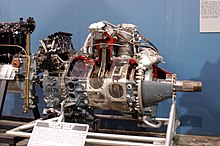
Data from Jane's.[9]
General characteristics
- Type: Twin-row 18-cylinder radial engine
- Bore: 6+1⁄8 in (155.6 mm)
- Stroke: 6+5⁄16 in (160.3 mm)
- Displacement: 3,347.9 in3 (54.862 L)
- Length: 76.26 in (1,937 mm)
- Diameter: 55.78 in (1,417 mm)
- Dry weight: 2,670 lb (1,210 kg)
Components
- Valvetrain: Pushrod, two valves per cylinder
- Supercharger: Two-speed single-stage
- Fuel system: Chandler-Evans downdraft carburetor
- Fuel type: 100/130 RON
- Oil system: Dry sump
- Cooling system: Air-cooled
Performance
- Power output: 2,200 hp (1,600 kW) at 2,800 rpm (takeoff)
- Specific power: 0.66 hp/in³
- Compression ratio: 6.85:1
- Specific fuel consumption: Takeoff: 0.38 lb/(hp⋅h) (0.17 kg/(hp⋅h); 0.23 kg/kWh)[10]
- Power-to-weight ratio: 0.82 hp/lb
See also
[edit]Related development
- Wright Cyclone series
- Wright R-1300 Cyclone 7
- Wright R-1820 Cyclone 9
- Wright R-2600 Cyclone 14
- Wright R-4090 Cyclone 22
Comparable engines
- BMW 802
- Bristol Centaurus
- Dobrynin VD-4K
- Gnome-Rhône 18L
- Nakajima Homare
- Pratt & Whitney R-4360 Wasp Major
- Shvetsov ASh-73
Related lists
References
[edit]Notes
[edit]- ^ "SUMMARY OF WRIGHT ENGINE SHIPMENTS 1920 – 1930" (PDF). Archived from the original (PDF) on 2021-10-10. Retrieved 2023-09-18.
- ^ Dreizin, Edward L.; Berman, Charles H. & Vicenzi, Edward P. (2000). "Condensed-phase modifications in magnesium particle combustion in air". Scripta Materialia. 122 (1–2): 30–42. Bibcode:2000CoFl..122...30D. CiteSeerX 10.1.1.488.2456. doi:10.1016/S0010-2180(00)00101-2.
- ^ "B-29." fighter-planes.com. Retrieved: 15 September 2011.
- ^ Gunston 2006, p. 247.
- ^ "The Wright R-3350 Turbo-Compound Engine". Sport Aviation: 20. April 2012.
- ^ American Aviation 4 Nov 1957 p57
- ^ "The Bear is Back". Smithsonian Air & Space Magazine. Archived from the original on 23 April 2022. Retrieved 29 August 2022.
- ^ Doyle p 71
- ^ Jane's 1998, p. 318
- ^ Kaiser, Sascha; Donnerhack, Stefan; Lundbladh, Anders; Seitz, Arne (27–29 July 2015). A composite cycle engine concept with hecto-pressure ratio. AIAA/SAE/ASEE Joint Propulsion Conference (51st ed.). doi:10.2514/6.2015-4028.
Bibliography
[edit]- Gunston, Bill. World Encyclopedia of Aero Engines: From the Pioneers to the Present Day. 5th edition, Stroud, UK: Sutton, 2006. ISBN 0-7509-4479-X
- White, Graham. Allied Aircraft Piston Engines of World War II: History and Development of Frontline Aircraft Piston Engines Produced by Great Britain and the United States During World War II. Warrendale, Pennsylvania: SAE International, 1995. ISBN 1-56091-655-9
- Jane's Fighting Aircraft of World War II. London. Studio Editions, 1998. ISBN 0-517-67964-7.
- Doyle, David. "B-29 Superfortress Vol. 1" Schiffer Publishing Ltd. 2020 ISBN 978-0-7643-5937-8

